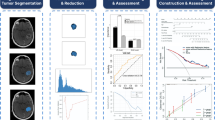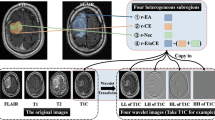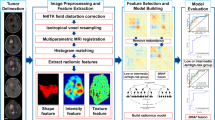Abstract
To investigate the radiomic features associated with Ki-67 expression in lower grade gliomas and assess the prognostic values of these features. Patients with lower grade gliomas (n = 117) were randomly assigned into the training (n = 78) and validation (n = 39) sets. A total of 431 radiological features were extracted from each patient. Differential radiological features between the low and high Ki-67 expression groups were screened by significance analysis of microarrays. Then, generalized linear analysis was performed to select features that could predict the Ki-67 expression level. Predictive efficiencies were further evaluated in the validation set. Cox regression analysis was performed to investigate the prognostic values of Ki-67 expression level and Ki-67-related radiological features. A group of nine radiological features were screened for prediction of Ki-67 expression status; these achieved accuracies of 83.3% and 88.6% (areas under the curves, 0.91 and 0.93) in the training and validation sets, respectively. Of these features, only spherical disproportion (SD) was found to be a prognostic factor. Patients in the high SD group exhibited worse outcomes in the whole cohort (overall survival, p < 0.0001; progression-free survival, p < 0.0001). Ki-67 expression level and SD were independent prognostic factors in the multivariate Cox regression analysis. This study identified a radiomic signature for prediction of Ki-67 expression level as well as a prognostic radiological feature in patients with lower grade gliomas.


Similar content being viewed by others
References
Cancer Genome Atlas Research N, Brat DJ, Verhaak RG et al (2015) Comprehensive, integrative genomic analysis of diffuse lower-grade gliomas. N Engl J Med 372:2481–2498. doi:10.1056/NEJMoa1402121
van den Bent MJ (2014) Practice changing mature results of RTOG study 9802: another positive PCV trial makes adjuvant chemotherapy part of standard of care in low-grade glioma. Neuro Oncol 16:1570–1574. doi:10.1093/neuonc/nou297
Kogiku M, Ohsawa I, Matsumoto K et al (2008) Prognosis of glioma patients by combined immunostaining for survivin, Ki-67 and epidermal growth factor receptor. J Clin Neurosci 15:1198–1203. doi:10.1016/j.jocn.2007.11.012
Wakimoto H, Aoyagi M, Nakayama T et al (1996) Prognostic significance of Ki-67 labeling indices obtained using MIB-1 monoclonal antibody in patients with supratentorial astrocytomas. Cancer 77:373–380
Duregon E, Bertero L, Pittaro A et al (2016) Ki-67 proliferation index but not mitotic thresholds integrates the molecular prognostic stratification of lower grade gliomas. Oncotarget 7:21190–21198. doi:10.18632/oncotarget.8498
Johannessen AL, Torp SH (2006) The clinical value of Ki-67/MIB-1 labeling index in human astrocytomas. Pathol Oncol Res 12:143–147
Zeng A, Hu Q, Liu Y et al (2015) IDH1/2 mutation status combined with Ki-67 labeling index defines distinct prognostic groups in glioma. Oncotarget 6:30232–30238. doi:10.18632/oncotarget.4920
Liu Y, Tang K, Yan W et al (2013) Identifying Ki-67 specific miRNA–mRNA interactions in malignant astrocytomas. Neurosci Lett 546:36–41. doi:10.1016/j.neulet.2013.04.030
Bai HX, Lee AM, Yang L et al (2016) Imaging genomics in cancer research: limitations and promises. Br J Radiol 89:20151030. doi:10.1259/bjr.20151030
Kuo MD, Jamshidi N (2014) Behind the numbers: Decoding molecular phenotypes with radiogenomics–guiding principles and technical considerations. Radiology 270:320–325. doi:10.1148/radiol.13132195
Ryu YJ, Choi SH, Park SJ et al (2014) Glioma: application of whole-tumor texture analysis of diffusion-weighted imaging for the evaluation of tumor heterogeneity. PLoS One 9:e108335. doi:10.1371/journal.pone.0108335
Liu C, Zhang H, Pan Y et al (2012) Towards MIB-1 and p53 detection in glioma magnetic resonance image: a novel computational image analysis method. Phys Med Biol 57:8393–8404. doi:10.1088/0031-9155/57/24/8393
Yan W, Zhang W, You G et al (2012) Molecular classification of gliomas based on whole genome gene expression: a systematic report of 225 samples from the Chinese Glioma Cooperative Group. Neuro Oncol 14:1432–1440. doi:10.1093/neuonc/nos263
Aerts HJ, Velazquez ER, Leijenaar RT et al (2014) Decoding tumour phenotype by noninvasive imaging using a quantitative radiomics approach. Nat Commun 5:4006. doi:10.1038/ncomms5006
Cai J, Zhang C, Zhang W et al (2016) ATRX, IDH1-R132H and Ki-67 immunohistochemistry as a classification scheme for astrocytic tumors. Oncoscience 3:258–265 doi:10.18632/oncoscience.317
Mazurowski MA (2015) Radiogenomics: what it is and why it is important. J Am Coll Radiol 12:862–866. doi:10.1016/j.jacr.2015.04.019
Zinn PO, Mahajan B, Sathyan P et al (2011) Radiogenomic mapping of edema/cellular invasion MRI-phenotypes in glioblastoma multiforme. PLoS ONE 6:e25451. doi:10.1371/journal.pone.0025451
Kickingereder P, Gotz M, Muschelli J et al (2016) Large-scale radiomic profiling of recurrent glioblastoma identifies an imaging predictor for stratifying anti-angiogenic treatment response. Clin Cancer Res. doi:10.1158/1078-0432.CCR-16-0702
Zhang B, Chang K, Ramkissoon S et al (2016) Multimodal MRI features predict isocitrate dehydrogenase genotype in high-grade gliomas. Neuro Oncol. doi:10.1093/neuonc/now121
Korfiatis P, Kline TL, Coufalova L et al (2016) MRI texture features as biomarkers to predict MGMT methylation status in glioblastomas. Med Phys 43:2835. doi:10.1118/1.4948668
Alexiou GA, Zikou A, Tsiouris S et al (2014) Correlation of diffusion tensor, dynamic susceptibility contrast MRI and (99 m)Tc-Tetrofosmin brain SPECT with tumour grade and Ki-67 immunohistochemistry in glioma. Clin Neurol Neurosurg 116:41–45. doi:10.1016/j.clineuro.2013.11.003
Fudaba H, Shimomura T, Abe T et al (2014) Comparison of multiple parameters obtained on 3 T pulsed arterial spin-labeling, diffusion tensor imaging, and MRS and the Ki-67 labeling index in evaluating glioma grading. AJNR 35:2091–2098. doi:10.3174/ajnr.A4018
Molina D, Perez-Beteta J, Martinez-Gonzalez A et al (2016) Influence of gray level and space discretization on brain tumor heterogeneity measures obtained from magnetic resonance images. Comput Biol Med 78:49–57. doi:10.1016/j.compbiomed.2016.09.011
Chen W-J, He D-S, Tang R-X et al (2015) Ki-67 is a valuable prognostic factor in gliomas: evidence from a systematic review and meta-analysis. Asian Pac J Cancer Prev 16:411–420. doi:10.7314/apjcp.2015.16.2.411
Itakura H, Achrol AS, Mitchell LA et al (2015) Magnetic resonance image features identify glioblastoma phenotypic subtypes with distinct molecular pathway activities. Sci Transl Med 7:303ra138. doi:10.1126/scitranslmed.aaa7582
Larsson O, Wahlestedt C, Timmons JA (2005) Considerations when using the significance analysis of microarrays (SAM) algorithm. BMC Bioinformatics 6:129. doi:10.1186/1471-2105-6-129
Soch J, Haynes JD, Allefeld C (2016) How to avoid mismodelling in GLM-based fMRI data analysis: cross-validated Bayesian model selection. NeuroImage 141:469–489 doi:10.1016/j.neuroimage.2016.07.047
Matas M, Picornell A, Cifuentes C et al (2013) Generalized Linear Model (GLM) framework for the association of host variables and viral strains with liver fibrosis in HCV/HIV coinfected patients. Infect Genet Evol 13:284–291 doi:10.1016/j.meegid.2012.10.020
Funding
This study was supported by the Beijing Natural Science Foundation (No. 7174295) and the National Natural Science Foundation of China (No. 81601452).
Author information
Authors and Affiliations
Corresponding authors
Additional information
Yiming Li and Zenghui Qian contributed equally to this work and they are both the first authors of this article.
Electronic supplementary material
Below is the link to the electronic supplementary material.
11060_2017_2576_MOESM2_ESM.tif
Supplementary Fig. 2 Magnetic resonance images of two patients with lower glioma with different Ki-67 expression levels. Case 1 was that of a 25-year-old woman with low Ki-67 expression level, who was correctly classified into the low Ki-67 group on basis of the radiomic signature. Case 2 was that of a 39-year-old man with high Ki-67 expression level, who was correctly classified into the high Ki-67 group. (TIF 3856 KB)
Rights and permissions
About this article
Cite this article
Li, Y., Qian, Z., Xu, K. et al. Radiomic features predict Ki-67 expression level and survival in lower grade gliomas. J Neurooncol 135, 317–324 (2017). https://doi.org/10.1007/s11060-017-2576-8
Received:
Accepted:
Published:
Issue Date:
DOI: https://doi.org/10.1007/s11060-017-2576-8




